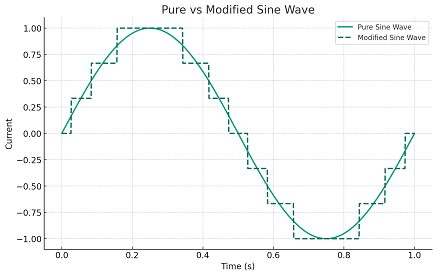20 July 2023
In the ever-evolving landscape of commercial vehicles, a crucial component that often goes unnoticed is the power inverter. These electronic powerhouses play a pivotal role in providing AC power from DC sources, powering equipment and devices in modern trucks, vans, and cars, particularly those using electric and hybrid technologies.
This comprehensive blog post aims to shed light on the significance of power inverters, their functionalities, and applications in commercial vehicles. Moreover, it will serve as a step-by-step guide to help you determine the right power inverter size for your unique requirements, while also addressing the continuous vs. peak power output dilemma.
Working Principle: Converting DC to AC Power
At the core of every power inverter lies the fundamental ability to convert direct current (DC) power into alternating current (AC) power. This transformation is vital as many devices and appliances used in commercial vehicles rely on AC power to function efficiently.
[Insert an infographic or chart depicting common electrical devices used in commercial vehicles and their wattage ratings.]
The inverter's role is to ensure a seamless conversion, making it possible to power everything from essential safety equipment to modern amenities with ease.
Importance in Commercial Vehicles
For commercial vehicle owners, fleet managers, and automotive enthusiasts, understanding the importance of power inverters cannot be overstated. These inverters serve as the backbone of power management systems in electric and hybrid trucks, vans, and cars, making them indispensable for day-to-day operations. Whether it's supplying electricity to work tools, refrigeration units, or electronic displays, the reliable operation of inverters is critical for business efficiency.
Advantages and Challenges
The advantages of using power inverters in commercial settings are manifold. They enable enhanced energy efficiency, reduce carbon emissions, and provide a more sustainable transportation solution. Additionally, inverters contribute to reduced noise pollution compared to traditional internal combustion engines, making them ideal for urban and noise-sensitive areas. However, challenges may arise in terms of cost, installation, and maintenance, which we will address later in this guide.
Real-World Examples
Let's delve into some real-world examples of how power inverters have revolutionised commercial vehicles:
Electric Refrigeration Units in Delivery Trucks: Inverters power the refrigeration units in delivery trucks, ensuring perishable goods remain fresh during transportation.
Mobile Workstations in Service Vans: Inverters enable service vans to operate as mobile workstations, with tools and equipment running on AC power, enhancing productivity.
Electric Ambulances: Inverters play a critical role in electric ambulances, providing uninterrupted power to medical equipment during emergency situations.
Step-by-Step Guide: What Size Power Inverter Do You Need for Your Commercial Vehicle
Step 1: Assess Your Power Requirements
To determine the appropriate power inverter size for your commercial vehicle, the first step is to assess your power requirements. Create a comprehensive list of all the electrical devices and appliances that need to be powered by the inverter. Note down their wattage ratings and estimate the total power required to run them effectively.
Step 2: Calculate Watts (W)
Use the calculator below to find the wattage (W) of each device based on its voltage (V) and current in amps (A).
Watts Calculator
Watts Calculator
Simply enter the voltage (V) and current (Amps) of each device in the calculator, and it will display the wattage (W) for that device. You can use this information to estimate the overall power demand for your commercial vehicle.
Step 3: Consult Power Inverter Size Charts or Manufacturers
To make an informed decision, consult power inverter size charts or reputable manufacturers for guidance on what size power inverter you need. Manufacturers often provide recommendations based on various vehicle and power scenarios, helping you choose the most suitable inverter size.
Step 4: Striking the Right Balance
Finding the right balance between capacity and cost-effectiveness is essential. Evaluate your actual power needs to avoid unnecessary costs and lower efficiency. While a larger inverter may offer more headroom for future power demands, it might not be the most cost-effective solution for devices operating at lower power levels.
Step 5: Continuous vs. Peak Power Outputs
Understanding the difference between continuous and peak power outputs of inverters is crucial. The continuous power output represents the maximum power the inverter can sustain over long periods, while the peak power output indicates the short bursts of power the inverter can handle for brief moments. Ensure that the selected inverter can handle the continuous power requirements of your devices while also accommodating peak demands without overloading the inverter.
Pure Sine Wave: Identical to the Power at Your Home
A pure sine wave power inverter produces an electrical waveform that is identical to the smooth and consistent power delivered by your home's electrical grid.

This clean power output ensures that sensitive electronic devices, such as laptops, medical equipment, and entertainment systems, run smoothly and without interference.
Safety/Protection Features
Power inverters come equipped with various safety and protection features to safeguard both the inverter and the connected devices:
Input Voltage Protection: The inverter may shut down if the input voltage is too low or too high, protecting it from potential damage.
Overload and Short Circuit Protection: Inverters have overload and short circuit protection, which trips the unit off if the load is too high or if there is a short circuit. If the inverter keeps tripping, ensure that the system is not being overloaded by doing a power consumption calculation.
Start-up Surge Allowance: Most inverters allow double the wattage for up to 5 seconds, allowing devices like fridges and washing machines, which have a power spike at startup, to operate smoothly.
Future Prospects
The future of power inverters in the commercial vehicle industry is promising. Advancements in power electronics, battery technologies, and smart energy management systems will likely lead to even more efficient and compact inverters. With a growing focus on sustainability, power inverters will play a pivotal role in driving the adoption of electric and hybrid commercial vehicles, contributing to a greener and more sustainable future for the transportation sector.